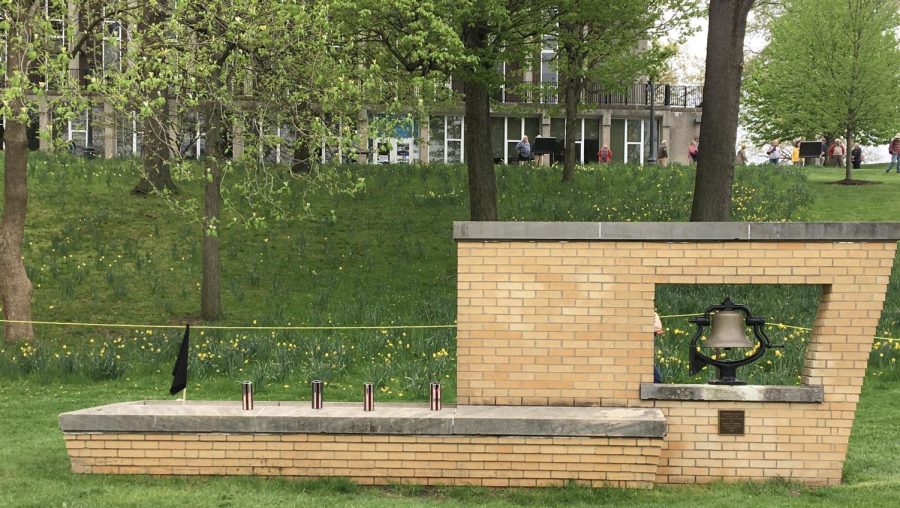51 years and counting: People gather to commemorate May 4, 1970
May 4, 2021
For the past 51 years, people have continued to gather to remember those who were killed and wounded during the Kent State shootings on May 4, 1970. Although the official commemoration was hosted virtually, approximately 65 people gathered at the Victory Bell to remember that day, 51 years later.
Laura Davis, a survivor of May 4, 1970, compares the commemorations to the musical “Brigadoon,” where once every 100 years, a mythical village opens its gates to the real world. For her, May 1 through May 4 feels like those gates open up and remind everyone of the tragedy of May 4, 1970.
“…the world just becomes different for these several days,” Davis said. “It’s actually very painful and it’s very emotional, and this year Alan’s death makes it so much harder. And then the gates close up again, but that doesn’t mean that we don’t tell the story, that we don’t try to educate people all the time.”
This year, Roseann “Chic” Canfora, May 4 survivor and sister of Alan Canfora, rang the bell 15 times in memory of the four students who died, the nine who were wounded and the two students who died at Jackson State University on May 15, 1970. Alan, one of the nine students who was wounded, died in Dec. 2020 at the age of 71.
“It is my privilege, for the first time in the 51 years that I’ve come back here, to ring the bell at 12:24,” Canfora said.
Tim Doescher was on campus on May 4, 1970. Coming back to Kent State brings up painful memories, but he wants people to remember what happened.
“The spirit of what happened that day and the memory of it needs to live on,” Doescher said. “A lot of people don’t even know what Kent State was about on May 4. I think by us showing up here as long as we can and having some kind of commemoration helps bring that back to light.”
Davis and Doescher were at the protest together and eventually split up before the shooting. Davis went towards the top of the hill behind the guardsman by Lake Hall and watched the shooting unfold.
“As soon as I got to the very top of the hill, they turned in unison, they positioned their rifles in unison, and began to fire,” Davis said. “I didn’t run. I more like froze and just kind of curled over and balled up my fists… and I just started screaming ‘They’re shooting their guns! They’re shooting their guns!’”
The pain and grief still live with the survivors of May 4, 1970. Doescher said talking about May 4 is difficult for him and going to the commemoration has helped him process the pain.
“The whole thing with the gunfire, when it happened was totally unexpected,” Doescher said. “I mean, there was nobody in their way, there was nobody close. They just turned on a dime like that at the top of the hill and I’ve seen how they started shooting down the hill.”
Along with the four markers for the students who died in the shootings, there are now markers to show where the nine wounded students were shot.
“This is the year that they… laid the markers to the nine wounded,” Canfora said. “When I was on the hill last night and I saw the candles placed on those markers, and you stand up there where the triggermen aimed their weapons at us, you could really see the distances that those bullets traveled.”
Alan Canfora was heavily involved in making sure the markers were accurate, even going as far as going through trial testimonies and ballistics reports to get the precise measurements. Chic remembers Alan measuring where the markers would be placed on Dec. 20, 2019, directly a year before he died.
The commemoration is bittersweet for Canfora. She struggled with processing the trauma of what happened and grappled with how to move forward.
“My first time back was the first anniversary, and I was dealing with my own trauma and I had a lot of bitterness over the years…” Canfora said. “It’s very, very hard for me to forgive the National Guardsmen. It still is. I will never forgive them for what they did. But it was very, very hard for me for years to forgive the university for abandoning us and leaving us so vulnerable to attack.”
Canfora said the support from the current Kent State administration is a turning point in remembering May 4, 1970 and in continuing to educate people about what happened.
“You can have a monument or memorial, and it doesn’t tell that story,” Canfora said. “But just with those markers and those candles where the four students fell, who died, and the nine who were wounded, it just screams injustice through the candles.”
Contact Molly Heideman at [email protected].
Contact Sara Crawford at [email protected].












